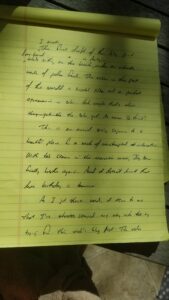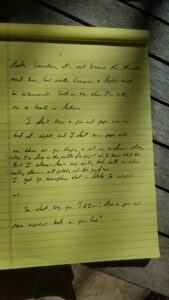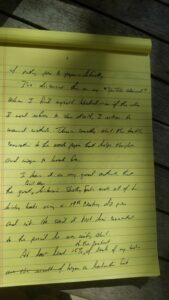 I wrote the first draft of this blog post longhand while sitting on a beach in Antigua, under an umbrella made of palm fronds. The ocean in this part of the world is crystal clear and a perfect aquamarine in color. Huh, maybe that’s where the color got its name. Huh.
I wrote the first draft of this blog post longhand while sitting on a beach in Antigua, under an umbrella made of palm fronds. The ocean in this part of the world is crystal clear and a perfect aquamarine in color. Huh, maybe that’s where the color got its name. Huh.
This is our annual spring sojourn to a beautiful place for a week of uninterrupted relaxation. With tax season in the rear view mirror, Joy can finally breathe again. And it doesn’t hurt that her birthday is tomorrow. As I jot these words, it occurs to me that I’ve vamped my way in to my topic for this week’s blog post: The value of putting pen to paper–literally.

I had no idea what this week’s post would be until I started stringing words together. Then it came to me. That’s the power of picking up a pen!
I’ve discussed this on my YouTube channel. When I find myself blocked–or if the idea I need refuses to show itself, I return to manual methods. There’s something about the tactile connection with the paper that helps words and images to break free.
I have it on very good authority that the great Civil War historian Shelby Foote wrote all of his history books using a 19th century dip pen and ink. He said it kept him connected to the period he was writing about.
At least 15% of the content of each of my books begin as handwritten first drafts. Sometimes, it’s not because the thoughts won’t come, but rather because a laptop is inconvenient. Say, for example, when I’m sitting on a beach in Antigua.
I don’t keep a pen and paper near my bed at night, and I don’t carry paper with me on routine outings such as shopping, or going out on a dinner date–unless I’m deep in the middle of a project and I know that the

It’s not uncommon for edits to run for over a page in the spaces between the lines of the original text. It can get confusing during rewrites.
writing demons will probably not let go of me. But I always have my writing tools with me when I go someplace that is likely to inspire me.
Just as an aside, if I had been drafting a section of a book by hand, I would have included a slug line at the top that would show the date and my location at the time I was drafting it. That has no practical rationale in real time, but now that I’ve been doing this for a couple of decades, it’s nice to remember where I was, back in the day.
So, what say you, TKZers? Are a pen and paper important tools in your box?


I’m on the computer all day at work..I don’t want to be anywhere near a computer when I come home.
When I write on the computer I go into “business mode”. When I write longhand, it comes from the heart.
I don’t think I’ve composed anything on paper but letters home since I learned to type in the tenth grade. And lots of letters home were typed–even on aerograms. But paper and pencil are valuable in a couple of ways.
Right now I’m editing a print-out of my WIP. I see lots of things I didn’t see on umpteen run-throughs on the computer. I mess with the corrections–some quite long–on the paper, keeping a large eraser handy. I’ll also use p-&-p for edits that involve moving stuff around. I can lose my way using cut-and-paste on the computer screen.
Yesterday I was in a brainstorm mode, trying to think through backstory, clues and reveals for the major subplot. Jotting ideas, words, quasi-outline sections on paper works better than trying to do that on, say, the Scrivener scratchpad. I write different things on different bits of the paper, scratch stuff out (not the same as deleting), draw arrows, etc. But I’ll do the actual composing on the computer, probably in new Scrivener docs that I’ll then paste into the main flow of the draft/manuscript.
My father was doing his doctor’s dissertation when I was home from college one summer. He wanted me to type his draft. No way I could read his handwriting, let alone follow all the arrows, margin notes and scratch-outs. So he read it to me while I typed. I think my mother typed his final draft–or the penultimate draft before he sent it to a professional for the final.
I do my development with paper and pencil. I brainstorm scenes and possibilities, circling potentials and then I branch out from there. “What could happen from here?” I use paper taken from the copy room trash cans. Everybody prints one-sided. Why kill more trees? I have reams of the stuff at work, at home, in my car. And I use a Pentel P207 0.7mm mechanical pencil, blue (in a pinch, I could use a .05, but it’s a little distracting).
I work more hours than a man should be allowed, so a lot of my development happens at work. I do it during my morning and afternoon breaks. I do it after lunch. I do it during crowded meetings where I’m not the guy talking and the topic is already well-understood.
Writing the actual story longhand does happen on occasion, but not often. This is first draft type stuff I write in my car when I’ve taken one of my kids to trumpet, tennis or wrestling practice, or my wife wants to hit the mall for a bit of shopping (she’s usually pleased if I stay behind, in the car).
A 0.7mm man!
I have for 30+ years used a machine pencil. Rotrig 600 0.7mm with B leads. My children use them as well. Bugs the crap out of their teachers. A B lead is the same darkness as a #1 pencil. More than dark enough for a standardized test. No yellow crap pencils in my house.
I was touring the Galapagos. I knew the small yacht wouldn’t have any sort of internet connection, so I brought a journal and pen, thinking I might get some plotting done while unplugged. I did keep a sketchy record of the islands we visited, the species we saw, but when I tried to make sense of my notes, it drove home the point that I can’t “plot” in advance, AND, I can barely read my writing. I’ve grown so accustomed to being able to type almost as fast as I can think that the longhand method ends up being a hot mess. Until there’s a pen with cut/copy/paste options, I’m doomed.
However, I do print out scenes in hard copy and make editing notes in longhand. (And I do use the backs of those pages again.)
I’ll use paper and ink for brainstorming, mind-mapping, doodling, etc., when I’m developing an idea. But when it comes to words, I always type. I don’t want to have to repeat my labors. My hale and hearty AlphaSmart goes out with me often for pure typing, leaving the laptop sleeping at home.
On those occasions when I don’t have a keyboard and the Muse caresses me, I’ll use my phone to do a little dictating into Google Docs.
That’s my standard MO. However, a couple of years ago, my wife drove the two of us to visit her father, and I took the opportunity to write using a legal pad and pen. While I normally insist on total silence to write, the car radio, traffic noise, and my wife’s occasional questioning of the legitimacy of other drivers didn’t bother me. In fact, I wrote one of my most successful short stories.
I’m curious, Mr. Bell … which AlphaSmart model do you have? I used to own a 3000 but it disappeared years ago.
The Neo. Keeps plugging along!
My situation is the same as what you described: when I’m stuck, or just need to noodle something out, I grab pen and paper for the same reason you describe: the tactile sensation seems to help me. I wonder if that’s something that will fall away as our generation does, as it seems to me the reason for this reliance on pen and paper might be a holdover to or childhoods, when we drew pictures or wrote stories with unfettered imaginations, pen(cil) and paper our only physical resources.
I frequently prefer handwriting over computer but I don’t do it as much as I’d like due to it being speedier to type instead of handwrite. I more naturally equate ‘problem solving’ with writing by hand then I do by typing.
How timely that you brought up this subject. I like to experiment, and I’m going to write all but the final version of my next short story long hand, just to see how it goes. I have a daily journaling habit, and I’ve noticed that the act of writing cursive relaxes me. It’ll be interesting to see if story ideas flow more easily when I’m relaxed.
I heard a podcast a couple of years ago about a research project to compare the results of taking class notes on a laptop vs writing longhand. The result was that students remembered the material better when notes were taken in longhand rather than typed. The underlying reason seemed to be that typing in class is just scribing, but writing in longhand requires more thought to choose the important concepts since it takes longer.
I’m not sure what this has to do with creative writing, but it appears there is a difference in the way we think when we’re doing one or the other.
I tend to do all my writing on my laptop, but I print out sections of the manuscript and make hand written notes on them for revision. I think I’ll try writing a few chapters in longhand to see if it makes a difference.
I used to write my scenes’ plot points on Post-It Notes. Writing by hand creates a different pathway to the brain (remember how we–if you’re my age–were taught to spell, by seeing the word, writing it in the air, writing it on paper, etc?). And condensing a scene to a 3×3 piece of paper forces you to hit the main points. But anything more than that is more than I can deal with.
I literally–in the true sense of the word–cannot read my own handwriting, so I must type everything. I learned to touch-type in the 10th grade and have hardly put pen to paper since. When I am away from the keyboard, I use my Neo.